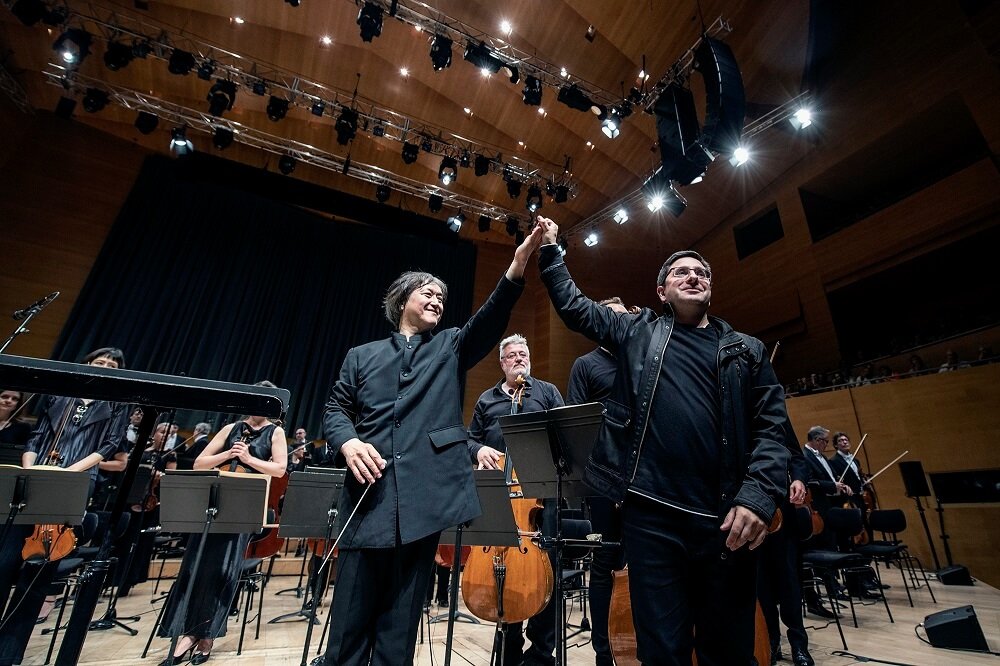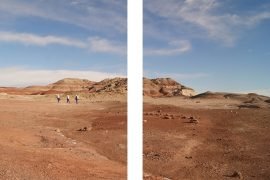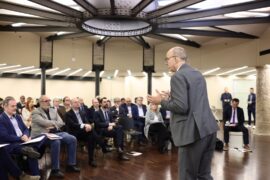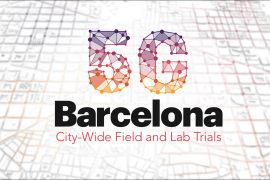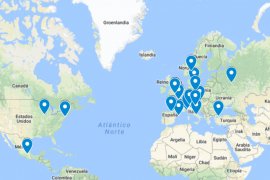After the general rehearsal, on the morning of Friday May 18, Héctor Parra ministers the press with commendable generosity and a smile that shows satisfaction with the work done. It seems to anticipate that the following day will be a success, as has rarely been the experience on the premiere of a work in the main concert hall of Barcelona’s Auditori. The creator of Inscape, a work commissioned by the OBC–Orquestra Sinfònica de Barcelona i Nacional de Catalunya together with soloists from the renowned Ensemble Intercontemporain—the orchestra founded by Pierre Boulez and specialising in experimental music—expresses himself with captivating, very informative ease.
Born in Barcelona in 1976, the son of a physicist, this composer passionately transmits the ideas that structure his work, making it more accessible to most listeners. A duty that weighs heavily upon many contemporary creators—artists do not always feel the need to fulfil such a requirement—but which instead he grasps as the perfect opportunity to foster the appreciation of his work. While Inscape rejects the programmatic nature of the symphonic poem, it does in fact narrate a cosmic journey, a transportation through an acoustic experience which will bring the listener closer to the limits of the audible.
BEYOND THE CONFINES OF THE REALITY OF THE SENSES
French astrophysicist Jean-Pierre Luminet, who accompanied Héctor Parra in the conception of the project, is equally accessible in his conversation with the press. He contributes with images, visual examples or reminiscences on the ancients, like Thales, Heraclitus, or Pythagoras, in order to illustrate the notion of the order that characterizes the cosmos, up to the limits of the rationally knowable. The reality of antimatter, the possibility that black holes connect different universes, or the sound of the universe itself—inaudible—are questions that the common mortal finds it difficult to delve into. Parra’s challenge is huge, in this sense. And yet, in his effort to materialize the immaterial—to verbalize the inaudible and achieve the propagation of sound waves that suggest other realities of physics—the listener discovers it is a portentous work, from an entirely musical perspective.

The complicity of director Kazushi Ono, who in several breaks in the rehearsal listens attentively to Parra’s indications, score in hand, is fundamental for the integration of the individual remarkably demanding efforts of the cadre of musicians. The method of extracting unusual sounds from classical instruments—a praxis the beginnings of which may be found in Mahler, precisely one of whose symphonies is programmed in the second part of the concert—is fascinating in its interaction with digital technology, taking advantage of Stockhausen’s electro-acoustic revolution and allowing him to transport the listeners beyond the confines of the reality of the senses, that which they believe they know.
“In his effort to materialize the immaterial—to verbalize the inaudible and achieve the propagation of sound waves that suggest that other reality of physics—which the listener discovers is a portentous work, from an entirely musical perspective”
Film lovers will likely be aware of the unusual lucidity of Stanley Kubrick, largely responsible for the soundtrack of his 2001: A Space Odyssey. In addition to his feat in achieving that the Blue Danube should convincingly illustrate the rotation of the space station, there is the effective use he made of Ligeti’s Atmosphères, pieces in which a sound is impossibly discerned—inaudible in principle—in a vacuum. The possibility of propagation of [sound] waves is the reality into which Parra plunges, with an ambitious orchestral proposal, which partially broadens the scope of the senses.
Sounds reverberate throughout, the capacity of the concert hall is colonized by waves, even exclaimed in almost silent whispers. In addition to the full orchestra led by the soloists of the Ensemble Intercontemporain, the composer has chosen to distribute groups of percussionists and brass and woodwind players in several boxes around the hall, producing an envelope of sound at specific moments, giving rise to a completely new experience, though strangely natural. Enjoyed in a mixture of amazement and familiarity through the organic, overwhelming character of a creation that sketches the physical reality of silence, it also very joyfully tortures the eardrums in what seems a celebration of the cosmos’ opposed order, which is at the same time what constitutes it: chaos.
INCOMPREHENSIBLE NATURE
The sensation of being subjected to this rhythmic and yet unpredictable influence during the audition of Inscape is difficult to express in words. And yet it makes it possible to understand unequivocally, through a very striking tonal richness—through the confluence and contrast of instruments of disparate sections—the reality of physis that other celebrities have already rehearsed. Impossible not to think of the The Rite of Spring due to the eventual prominence of the bassoon and the way percussion and brass imprint their agonizing rhythms, of clear Dionysian inspiration. But even if we believe we might spot another’s passage—Ligeti or Stravinsky, or even Takemitsu—Parra’s creation is absolutely original. It is stayed upon the numeral, as cannot be otherwise when dealing with the cosmos as its subject, but it is open to the influence of the unexpected, being that absolutely musical dialectic that generates addiction, and turns it into a massive work.
The reality of the void is mysterious, incomprehensible, but no more than the reality of being, and the propagation of waves that lead us to experience positively what there is. “Physis—as Heraclitus would say, referring to the most immediate and obvious reality, which cannot not be—likes to hide.” It is not that true reality resides in the occult, or shows itself superior to the senses, as philosophical and religious Platonism has insisted on emphasizing. Much more suggestive is the possibility—unsettling for some, plausible for others—that the difference between physics and metaphysics, between material and immaterial reality, is only a difference in degree.
“The reality of the void is mysterious, incomprehensible, but no more than the reality of being, and the propagation of waves that lead us to experience positively what there is.”
Certain mythical conceptions, in the origin of those first forms of wisdom that Jean-Pierre Luminet alluded to—mentioning Heraclitus, for example—insinuate in a non-discursive way the co-kinship of being and non-being, no longer understood in terms of exclusion but as a mutual condition of possibility. Héctor Parra’s journey, vertiginous and subtle depending on the region it might be passing through, is a brutal update of the tour that Gustav Mahler championed a century earlier in his Fourth Symphony, the work programmed in the second part of the concert. From a relentless gaze—common to both composers—we find, however, the true contemplation of nature, both of beauty, without a why or wherefore, as well as its thunderous power, which would seem to be meaningless—destruction tends to seem less understandable in the interest of humans.

Inscape, which will soon be performed in Paris, Lille and Cologne, imposes as an inspired sublimation of the longing for transcendence that nevertheless confirms that we are immersed in the flow of a changing reality—physis—both visible and invisible, understood from a fruitless and always provisional point of view. The role of certain solo instruments, specifically the flute, capture that attempt. But it is not the only voice that builds the fabric and faces the most radical vacuum. There are many attempts at colonization, and the merit of Parra’s work is the global, ambitious, sensitive effort to make the order of the cosmos audible, even in the vicinity of what has been called a black hole, the most dense reality that remorselessly engulfs any beam of matter.

